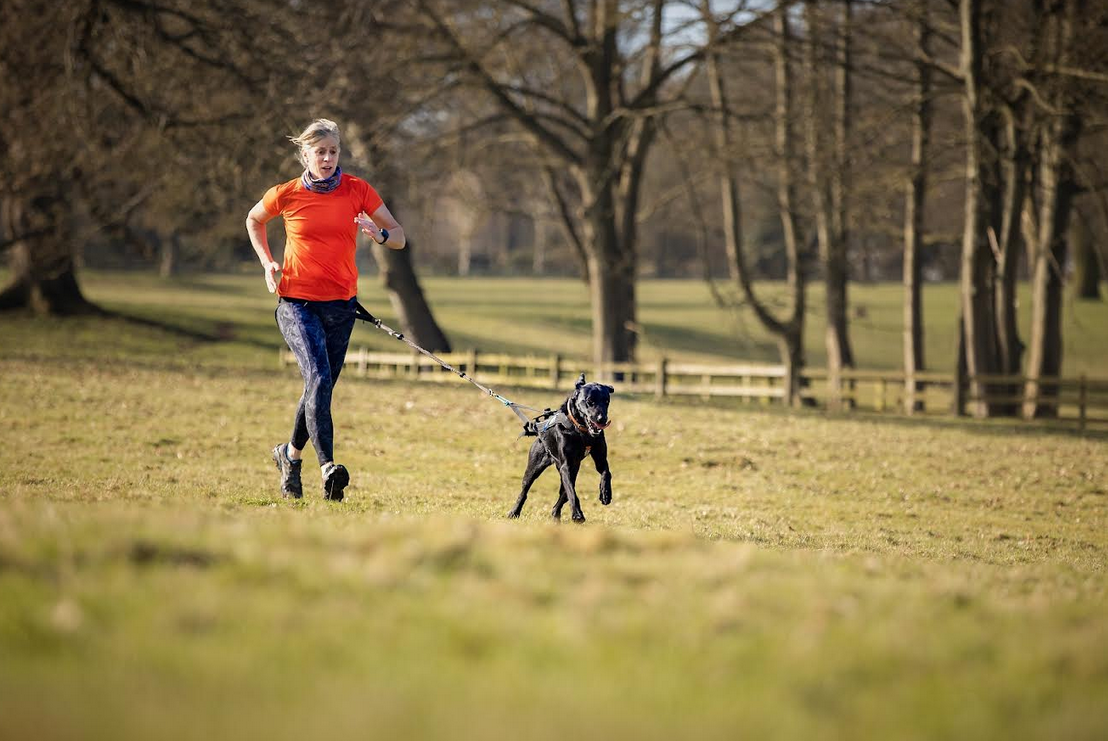Dogs may be man’s best friend, but did you know that your canine companion can also be the perfect workout buddy?
If you are a dog owner, you will understand the importance of making sure your dog gets regular exercise. Daily exercise keeps your pet healthy and can reduce or eliminate problematic behaviors.
But if you’re bored of your regular walking route, or your dog has more energy to burn, what about taking them for a run with you?

Photo credit: Louise Humphrey
Why you should consider running with your dog
Running with your dog is a great way to keep both yourself and your pet fit. Keeping fit and staying at a healthy weight is just as important for dogs as it is for humans, enabling them to live a long and happy life.
Since your dog needs exercise no matter the weather or your mood, running together will also help to motivate you to get out when you don’t feel like it. “Dogs are always keen to get out whatever the weather, so it’s like having your own “pawsonal” trainer!” says Louise Humphrey, a CaniCross (cross-country running with dogs) trainer.
Louise also says that running together can help to increase the bond between you and your dog. It allows you to spend quality time together doing an activity that you both enjoy. “While out with our dogs we have more time for bonding which can easily be reduced by busy lives,” says Joe Nutkins, a Certified Professional Canine Fitness Trainer.
Wait until your dog is old enough
Too much running can be dangerous for puppies, whose bones are still developing. Therefore, it’s best to wait until your dog is fully grown before training them to run with you. For most breeds, this will be around 18 months, but check with your vet or another appropriate expert if you’re not sure.
CaniCross Coach Anne-Marie Davison says, “No dog should be running before they are 12 months old for any duration. And for some breeds of dog with larger frames, it is best to wait longer before you run them to allow their growth plates to close fully.”
Make sure your dog can run safely
Most dogs can and do enjoy running. However, they are not all capable of running long distances safely. Dogs with flat or “squashed” looking faces, known as brachycephalic dogs, will struggle to breathe over significant distances. These breeds, which include bulldogs and pugs, are not suited to running with humans.
Again, if you’re not sure if you can run with your dog safely, ask your vet or another qualified expert.
Build up slowly
Dogs, like humans, need time to adapt to new activities. So don’t expect your dog to run a marathon with you their first time out. Consider a graded program such as Couch-to-5k, and build up your running pace and distance slowly.
Pay attention to how your dog is responding. If they’re struggling or seem completely exhausted, pull back your speed and/or running distance. If they’re still raring to go after a run, it might be time to step things up a level.
Use the correct equipment
“You have two options when running your dog,” Anne-Marie explains. “You can either run off-lead, at which point it is essential that you have excellent recall and the ability to move your dog beyond distractions, or alternatively you can choose to run them attached to you, using a harness, line and waist belt.”
If you are running with your dog attached to you, it is vital to use the proper equipment to keep both of you safe. “We recommend that dogs wear a correctly fitting Y front harness designed for running and Canicross,” Anne-Marie says. This type of harness is more comfortable for your dog, giving them free movement in their legs, and safer for you. “The harness sits on the pelvis (not the lower back), one of the strongest parts of the body which can take the stress of the dog pulling,” says Louise.
You can also get harnesses that have a strap across the chest, but this type of harness can restrict shoulder movement and change the dog’s gait.

Photo credit: Louise Humphrey
Get expert tuition
When you first start running with your dog, it’s a good idea to find an experienced trainer who can help you. They can advise you on the proper technique, ensure things are safe for both you and your dog, and help you choose the most appropriate equipment.
A good instructor will work with you and your dog, teaching you commands and training the dog to follow them. “Running your dog requires control and training,” says Anne-Marie. “The last thing you want is a very strong dog who doesn't listen, pulling you down the trail.”
You can also join a club, where you’ll be able to run with other dog-lovers and make new friends.
A few important safety tips
As you learn to run with your dog, these tips from our experts will keep both you and your dog safe and healthy:
- Don’t run your dog on pavement or concrete for any significant duration, as this can cause joint issues. “Softer ground will be a good cushion for you and your dog’s joints, especially when getting started,” says Joe.
- Carry water for you and your dog, as well as a small first aid kit.
- Don’t run your dog when it’s too hot, as this can cause heat stroke which can be fatal. Run early in the morning or later in the evening during summer.
- Always carry a charged mobile phone so you can call someone for help if you need to.
Running with your dog can be hugely enjoyable and rewarding for both of you. Be safe and have fun!
Read more

As the weather warms up and the days lengthen, people across the US and the world will be heading outdoors to enjoy hiking. Hiking—or vigorous, recreational walking in the countryside—has grown la...

According to the Health Policy Institute at Georgetown University, back pain is one of the most frequent complaints Americans make to their doctors. Around 65 million Americans report a recent epi...







Leave a comment
All comments are moderated before being published.
This site is protected by hCaptcha and the hCaptcha Privacy Policy and Terms of Service apply.